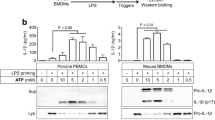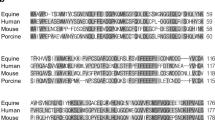Abstract
Inflammasomes, which are intracellular sensors of endogenous or exogenous danger signals, activate caspase-1, resulting in interleukin (IL)-1β maturation. Although most studies on inflammasomes have been performed in human and/or mouse-derived macrophages, porcine inflammasome activation has not been elucidated even though pigs are considered one of the best animal models for translational and preclinical investigations. In this study, we optimized detection of porcine IL-1β secretion, which is the most well established indicator of inflammasome activation, and compared inflammasome activation between miniature and domestic pigs as well as between porcine and murine macrophages. In our results, anti-sera against murine IL-1β had higher affinity to porcine IL-1β than anti-sera against human IL-1β, even though the amino acid sequence of porcine IL-1β was more similar to that of human IL-1β. In addition, there was no significant difference in inflammasome activation between miniature and domestic pigs. Furthermore, well established inflammasome triggers (ATP, nigericin, and crystals) in humans and mice had similar effects on porcine NLRP3 inflammasome activation. We further elucidated the upstream signaling pathway of porcine inflammasome activation using pharmacological inhibitors. Similar to the mechanisms of inflammasome activation in humans and mice, potassium efflux and reactive oxygen species generation were confirmed as key pathways in porcine inflammasome activation. Thus, inflammasome activation in pigs is not different from that in humans or mice.





Similar content being viewed by others
References
Ahn H, Kim J, Jeung EB, Lee GS (2013) Dimethyl sulfoxide inhibits NLRP3 inflammasome activation. Immunobiology. doi:10.1016/j.imbio.2013.11.003
Dinarello C, Arend W, Sims J, Smith D, Blumberg H, O'Neill L, Goldbach-Mansky R, Pizarro T, Hoffman H, Bufler P, Nold M, Ghezzi P, Mantovani A, Garlanda C, Boraschi D, Rubartelli A, Netea M, van der Meer J, Joosten L, Mandrup-Poulsen T, Donath M, Lewis E, Pfeilschifter J, Martin M, Kracht M, Muehl H, Novick D, Lukic M, Conti B, Solinger A, Kelk P, van de Veerdonk F, Gabel C (2010) IL-1 family nomenclature. Nat Immunol 11(11):973. doi:10.1038/ni1110-973
Dostert C, Guarda G, Romero JF, Menu P, Gross O, Tardivel A, Suva ML, Stehle JC, Kopf M, Stamenkovic I, Corradin G, Tschopp J (2009) Malarial hemozoin is a Nalp3 inflammasome activating danger signal. PLoS ONE 4(8):e6510. doi:10.1371/journal.pone.0006510
Englen MD, Valdez YE, Lehnert NM, Lehnert BE (1995) Granulocyte/macrophage colony-stimulating factor is expressed and secreted in cultures of murine L929 cells. J Immunol Methods 184(2):281–283
Halle A, Hornung V, Petzold GC, Stewart CR, Monks BG, Reinheckel T, Fitzgerald KA, Latz E, Moore KJ, Golenbock DT (2008) The NALP3 inflammasome is involved in the innate immune response to amyloid-beta. Nat Immunol 9(8):857–865. doi:10.1038/ni.1636
Hentze H, Lin XY, Choi MS, Porter AG (2003) Critical role for cathepsin B in mediating caspase-1-dependent interleukin-18 maturation and caspase-1-independent necrosis triggered by the microbial toxin nigericin. Cell Death Differ 10(9):956–968. doi:10.1038/sj.cdd.4401264
Hochrein H, Wagner H (2004) Of men, mice and pigs: looking at their plasmacytoid dendritic cells [corrected]. Immunology 112(1):26–27. doi:10.1111/j.1365-2567.2004.01878.x
Hornung V, Bauernfeind F, Halle A, Samstad EO, Kono H, Rock KL, Fitzgerald KA, Latz E (2008) Silica crystals and aluminum salts activate the NALP3 inflammasome through phagosomal destabilization. Nat Immunol 9(8):847–856. doi:10.1038/ni.1631
Hornung V, Ablasser A, Charrel-Dennis M, Bauernfeind F, Horvath G, Caffrey DR, Latz E, Fitzgerald KA (2009) AIM2 recognizes cytosolic dsDNA and forms a caspase-1-activating inflammasome with ASC. Nature 458(7237):514–518. doi:10.1038/nature07725
Kim J, Ahn H, Han BC, Lee SH, Cho YW, Kim CH, Hong EJ, An BS, Jeung EB, Lee GS (2014) Korean red ginseng extracts inhibit NLRP3 and AIM2 inflammasome activation. Immunol Lett 158(1–2):143–150. doi:10.1016/j.imlet.2013.12.017
Kwak HH, Park KM, Teotia PK, Lee GS, Lee ES, Hong SH, Yang SR, Park SM, Ahn C, Park CK, Lee KW, Woo HM (2013) Acute rejection after swine leukocyte antigen-matched kidney allo-transplantation in cloned miniature pigs with different mitochondrial DNA-encoded minor histocompatibility antigen. Transplant Proc 45(5):1754–1760. doi:10.1016/j.transproceed.2013.02.103
Laliberte RE, Eggler J, Gabel CA (1999) ATP treatment of human monocytes promotes caspase-1 maturation and externalization. J Biol Chem 274(52):36944–36951
Lamkanfi M (2011) Emerging inflammasome effector mechanisms. Nat Rev Immunol 11(3):213–220. doi:10.1038/nri2936
Lamkanfi M, Dixit VM (2011) Modulation of inflammasome pathways by bacterial and viral pathogens. J Immunol 187(2):597–602. doi:10.4049/jimmunol.1100229
Lee GS, Subramanian N, Kim AI, Aksentijevich I, Goldbach-Mansky R, Sacks DB, Germain RN, Kastner DL, Chae JJ (2012) The calcium-sensing receptor regulates the NLRP3 inflammasome through Ca2+ and cAMP. Nature 492(7427):123–127. doi:10.1038/nature11588
Li H, Willingham SB, Ting JP, Re F (2008) Cutting edge: inflammasome activation by alum and alum's adjuvant effect are mediated by NLRP3. J Immunol 181(1):17–21
Li Y, Xu S, Jiang B, Cohen RA, Zang M (2013) Activation of sterol regulatory element binding protein and NLRP3 inflammasome in atherosclerotic lesion development in diabetic pigs. PLoS ONE 8(6):e67532. doi:10.1371/journal.pone.0067532
Lloyd-Jones D, Adams RJ, Brown TM, Carnethon M, Dai S, De Simone G, Ferguson TB, Ford E, Furie K, Gillespie C, Go A, Greenlund K, Haase N, Hailpern S, Ho PM, Howard V, Kissela B, Kittner S, Lackland D, Lisabeth L, Marelli A, McDermott MM, Meigs J, Mozaffarian D, Mussolino M, Nichol G, Roger VL, Rosamond W, Sacco R, Sorlie P, Thom T, Wasserthiel-Smoller S, Wong ND, Wylie-Rosett J (2010) Heart disease and stroke statistics–2010 update: a report from the American Heart Association. Circulation 121(7):e46–e215. doi:10.1161/CIRCULATIONAHA.109.192667
Locovei S, Scemes E, Qiu F, Spray DC, Dahl G (2007) Pannexin1 is part of the pore forming unit of the P2X(7) receptor death complex. FEBS Lett 581(3):483–488. doi:10.1016/j.febslet.2006.12.056
Lunney JK, Benfield DA, Rowland RR (2010) Porcine reproductive and respiratory syndrome virus: an update on an emerging and re-emerging viral disease of swine. Virus Res 154(1–2):1–6. doi:10.1016/j.virusres.2010.10.009
Mariathasan S, Weiss DS, Newton K, McBride J, O'Rourke K, Roose-Girma M, Lee WP, Weinrauch Y, Monack DM, Dixit VM (2006) Cryopyrin activates the inflammasome in response to toxins and ATP. Nature 440(7081):228–232. doi:10.1038/nature04515
Martinon F, Tschopp J (2004) Inflammatory caspases: linking an intracellular innate immune system to autoinflammatory diseases. Cell 117(5):561–574. doi:10.1016/j.cell.2004.05.004
Martinon F, Petrilli V, Mayor A, Tardivel A, Tschopp J (2006) Gout-associated uric acid crystals activate the NALP3 inflammasome. Nature 440(7081):237–241. doi:10.1038/nature04516
Medzhitov R (2001) Toll-like receptors and innate immunity. Nat Rev Immunol 1(2):135–145. doi:10.1038/35100529
Munoz-Planillo R, Kuffa P, Martinez-Colon G, Smith BL, Rajendiran TM, Nunez G (2013) K(+) efflux is the common trigger of NLRP3 inflammasome activation by bacterial toxins and particulate matter. Immunity 38(6):1142–1153. doi:10.1016/j.immuni.2013.05.016
Palsson-McDermott EM, O'Neill LA (2004) Signal transduction by the lipopolysaccharide receptor, Toll-like receptor-4. Immunology 113(2):153–162. doi:10.1111/j.1365-2567.2004.01976.x
Pelegrin P, Surprenant A (2006) Pannexin-1 mediates large pore formation and interleukin-1beta release by the ATP-gated P2X7 receptor. EMBO J 25(21):5071–5082. doi:10.1038/sj.emboj.7601378
Perregaux D, Gabel CA (1994) Interleukin-1 beta maturation and release in response to ATP and nigericin. Evidence that potassium depletion mediated by these agents is a necessary and common feature of their activity. J Biol Chem 269(21):15195–15203
Qu Y, Franchi L, Nunez G, Dubyak GR (2007) Nonclassical IL-1 beta secretion stimulated by P2X7 receptors is dependent on inflammasome activation and correlated with exosome release in murine macrophages. J Immunol 179(3):1913–1925
Rathinam VA, Vanaja SK, Fitzgerald KA (2012) Regulation of inflammasome signaling. Nat Immunol 13(4):333–342. doi:10.1038/ni.2237
Schroder K, Zhou R, Tschopp J (2010) The NLRP3 inflammasome: a sensor for metabolic danger? Science 327(5963):296–300. doi:10.1126/science.1184003
Strowig T, Henao-Mejia J, Elinav E, Flavell R (2012) Inflammasomes in health and disease. Nature 481(7381):278–286. doi:10.1038/nature10759
Swindle MM, Smith AC, Hepburn BJ (1988) Swine as models in experimental surgery. J Invest Surg Off J Acad Surg Res 1(1):65–79
Swindle MM, Makin A, Herron AJ, Clubb FJ Jr, Frazier KS (2012) Swine as models in biomedical research and toxicology testing. Vet Pathol 49(2):344–356. doi:10.1177/0300985811402846
Tohno M, Shimosato T, Aso H, Kitazawa H (2011) Immunobiotic Lactobacillus strains augment NLRP3 expression in newborn and adult porcine gut-associated lymphoid tissues. Vet Immunol Immunopathol 144(3–4):410–416. doi:10.1016/j.vetimm.2011.09.010
Tschopp J, Schroder K (2010) NLRP3 inflammasome activation: the convergence of multiple signalling pathways on ROS production? Nat Rev Immunol 10(3):210–215. doi:10.1038/nri2725
Wen H, Ting JP, O'Neill LA (2012) A role for the NLRP3 inflammasome in metabolic diseases–did Warburg miss inflammation? Nat Immunol 13(4):352–357. doi:10.1038/ni.2228
Zhang K, Hou Q, Zhong Z, Li X, Chen H, Li W, Wen J, Wang L, Liu W, Zhong F (2013) Porcine reproductive and respiratory syndrome virus activates inflammasomes of porcine alveolar macrophages via its small envelope protein E. Virology 442(2):156–162. doi:10.1016/j.virol.2013.04.007
Zhao Y, Yang J, Shi J, Gong YN, Lu Q, Xu H, Liu L, Shao F (2011) The NLRC4 inflammasome receptors for bacterial flagellin and type III secretion apparatus. Nature 477(7366):596–600. doi:10.1038/nature10510
Zhou R, Yazdi AS, Menu P, Tschopp J (2011) A role for mitochondria in NLRP3 inflammasome activation. Nature 469(7329):221–225. doi:10.1038/nature09663
Acknowledgments
This research was supported by the Basic Science Research Program through the National Research Foundation of Korea (NRF) funded by the Ministry of Education, Science and Technology (NRF-2012R1A1A1001645), by a grant from the Next-Generation BioGreen 21 Program (No. PJ009069), Rural Development Administration, Republic of Korea
Ethical standard
All animal experiments were carried out in accordance with the National Institutes of Health Guide for the Care and Use of Laboratory Animals and approved by the Institutional Animal Care and Use Committee of Kangwon National University (ACUCC; approval no. KIACUC-12-0131).
Conflict of interest
The authors have no conflict of interest to declare.
Author information
Authors and Affiliations
Corresponding author
Additional information
Jeeyoung Kim and Huijeong Ahn contributed equally to this work.
Rights and permissions
About this article
Cite this article
Kim, J., Ahn, H., Woo, HM. et al. Characterization of porcine NLRP3 inflammasome activation and its upstream mechanism. Vet Res Commun 38, 193–200 (2014). https://doi.org/10.1007/s11259-014-9602-5
Accepted:
Published:
Issue Date:
DOI: https://doi.org/10.1007/s11259-014-9602-5




